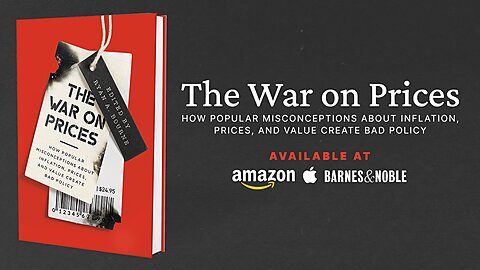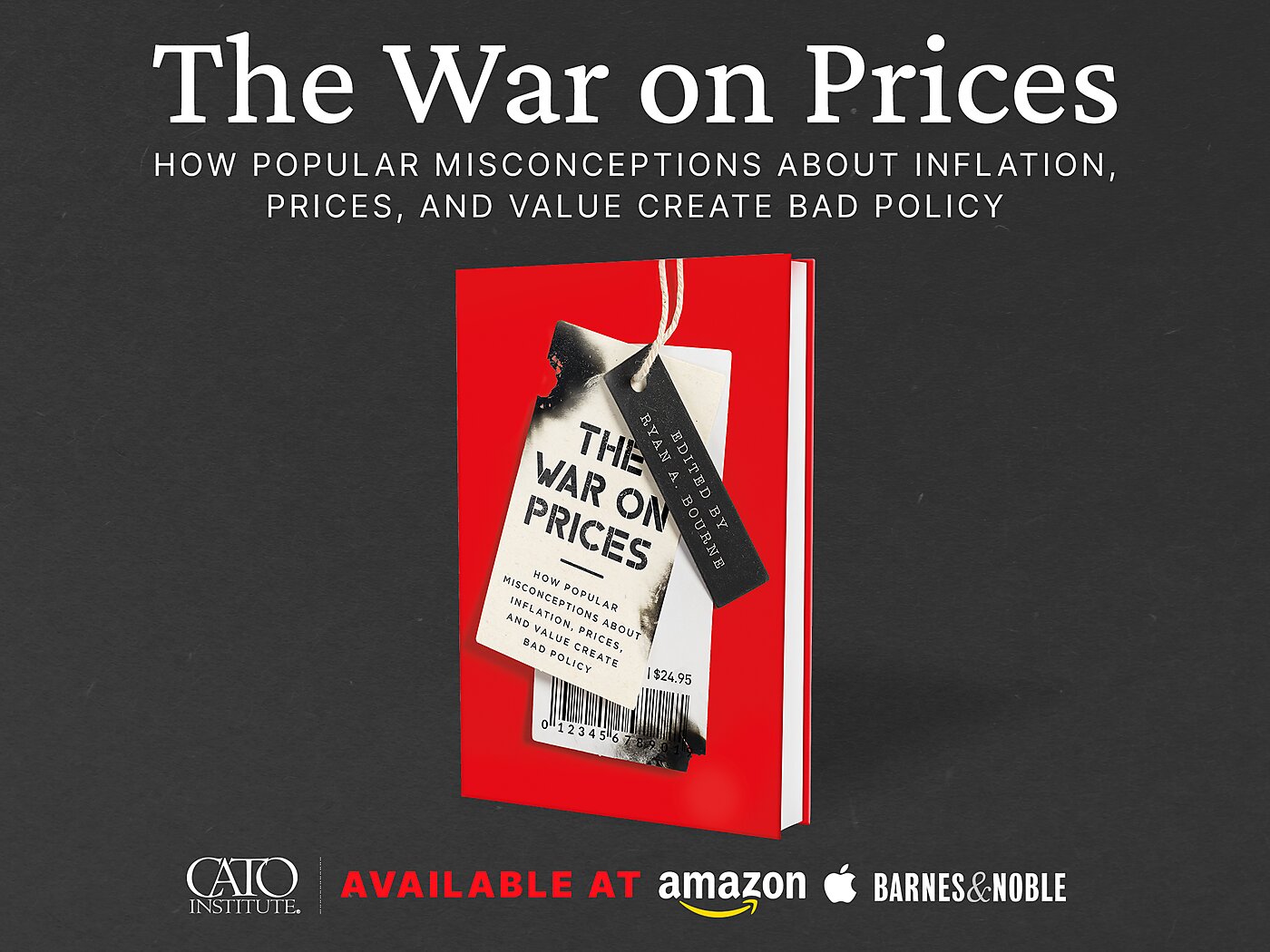
Note: This is an excerpt from my book The War on Prices.
High inflation and supply shocks in certain sectors since 2021 have helped revive the policy allure of price controls. After all, if rising prices are a problem, why not simply ban businesses from increasing them, particularly in “essential” sectors that are crucial to the well-being of the poor?
Governments have been interfering with prices for over 4,000 years. Economists overwhelmingly reject the theory that a general system of price controls (as in the 1940s and 1970s) can mitigate inflation, at least without serious harm. But a time of rapidly rising prices has nevertheless seen an increased interest in market-specific price controls, purportedly to help those struggling most with rising living costs.
In Europe, that took the form of capping the price of domestic energy and, in some countries, food prices. Here in the United States, we have seen a fresh outbreak in rent control proposals. But, in truth, there are many individual sectors in which the federal, state, and local governments have controlled or continue to control market prices already, often bringing substantial economic harm.
What Are Market Prices?
Few elements of economics are as fundamental as the concept of prices. At its crudest, a price is just the monetary value assigned to a product or service by whoever sets it. A market price is more interesting: it’s the amount of money that a buyer pays a seller in open exchange for a good or service.
Market prices are broadly determined by the supply and demand for the product in question—that is, they reflect the intersection of consumers’ preferences and willingness to pay with producers’ costs and willingness to supply. This distinguishes them from administered prices—those that are decreed by some authority, such as the government, or (theoretically) a monopoly with pricing power.
A lot of public discussion of prices takes place as if all prices are administered prices, in the sense of businesses having free rein to set them at whatever level they wish. In the real world, market prices rise and fall because of shifts in supply and demand. Firms can only profitably charge prices that (a) consumers are willing to pay and (b) competitors (current or potential) cannot easily undercut. A company may notionally set its own prices, but in anything other than the immediate term, the price it can sustainably charge is dictated by these broader forces.
Yet rather than see prices as the outcome of an ongoing market process, it’s common for the public to recoil at high prices, blaming them on market actors and appealing to governments to control them. Public opinion often casts prices as roadblocks to people’s dreams, deeming them “unreasonable” or “excessive.” Consider wanting to rent a decent house in a safe Northern Virginia neighborhood. It’s easy to label current rents as “ridiculous” and call for government intervention to cap them to make renting more affordable.
The perception of individual prices as “unfair” emerges partly from the very nature of market trades. Transactions occur when they benefit both parties—when the buyer values the product more than the money parted with, and the seller appreciates the cash more than the product relinquished. Each party to the transaction usually receives a surplus.
The consumer’s surplus is the difference between the maximum the buyer would be willing to pay and what the buyer ends up paying. The producer’s surplus is the difference between the sale price and the minimum the seller would be willing to accept. The fact that both parties consider themselves better off means that, technically, the seller would also be willing to accept a slightly lower price, and the buyer a slightly higher price, than agreed. Both sides can thus feel they have sacrificed a bit more than they really needed to, even if each is better off overall.
What Economic Role Do Prices Play?
Market prices are crucial to solving “the economic problem.” That is, they help us decide how to most effectively allocate scarce resources in a world of unlimited wants and needs.
Consider the myriad resources out there: my labor, copper, orange farms in Florida, homes in Milwaukee, tickets for a Taylor Swift concert, hospital beds, semiconductor factories, Walt Disney World hotels, and any other product or service you can think of. We could combine or use the labor, capital, land, and entrepreneurs available in trillions of different ways. We could, theoretically, place me in a hospital tomorrow to undergo coronary artery bypass surgery, surrounded by my Cato colleagues cosplaying doctors and nurses, under the management of Sen. Bernie Sanders (I‑VT). The results would be disastrous.
Without resorting to random resource allocation, we need a more refined mechanism. For a time in the 20th century, “central planning” was considered the silver bullet. Governments would assess societal needs, and experts would coordinate who does what and how.
Historical experiments like the Soviet Union demonstrated the disastrous inadequacy of this approach. Germany’s split into a democratic capitalist state in the West and a communist one in the East provide a perfect example. Around the time of Germany’s reunification, gross domestic product per capita in East Germany was less than half the level of that in West Germany.
A key reason for this is that no planner can harness the knowledge necessary to effectively allocate goods and services to their highest-value uses. Would my next-door neighbor be most effective as a medic, an economist, or a plumber? Should the local factory make cars or aircraft parts? How about the farm: Would the land be better deployed for a housing project? What is the most effective way for managers to motivate an individual worker? This information is not just dispersed and difficult to gather, but often tacit, rooted in instinctive or particular knowledge and experience.
Unlike a central planner, a market economy, through its price mechanism, can harness this knowledge. That is because all that knowledge is expressed in decisions that are driving supply and demand and thus prices. Prices are therefore crucial in coordinating our activity toward productive ends. They help communicate vast amounts of information from millions and millions of transactions, which then helps guide our plans toward acts that add value for others.
How does this work? Market prices encourage us to use resources more efficiently by providing people with signals about which plans they should undertake without the need for costly information gathering.
Prices capture the relative scarcity of different goods based on today’s context-specific conditions and communicate that information to everyone else. You don’t need to know that baby formula prices are rising because of a temporary factory closure. The higher price alone tells you it’s not the best time to make bulk purchases of baby formula, helping ration goods for those who value them most. Similarly, unaffected producers can see from the higher price that it’s more profitable to run overtime, fire up spare capacity, or run down inventories to provide more baby formula to the market now. The price increase therefore encourages an expansion of the quantity supplied, shifting us toward an efficient allocation of resources. Market prices thus help align the interests of buyers and sellers.
As George Mason University economist Alex Tabarrok puts it, “Prices are a signal wrapped up in an incentive.” That phrase captures prices’ dual economic role. Price movements provide information (the “signal”) about the broad state of the market that helps producers and consumers reassess their plans. Rising prices show that a good has seen either increased demand (perhaps because a substitute product has seen its price rise) or a fall in supply (perhaps because of a shortage of inputs or a natural disaster). Crucially, such movements provide an “incentive” that encourages buyers and sellers to use the scarce resource efficiently.
Not all market prices will be “correct” at any given time. In a market economy, we are all constantly involved in the trial-and-error process of trying to make better decisions. For companies, that means making myriad decisions at all times: Should we reorganize that team? Run a different advertising campaign? Sell those two products bundled together? Abandon this line of production entirely?
But prices themselves provide a crucial feedback mechanism for improving decisionmaking. That’s because the wisdom of past decisions can be assessed by using prices to compute revenues that we can then compare with costs of production (also prices) to examine profit and loss. This profit and loss information provides evidence on whether the new good, or the new management technique, or whatever else has been tested, generates net value.
If a healthy profit results from a new form of product, it signals to other entrepreneurs “more of this please,” attracting them into the market to offer similar goods at a higher quality or lower price. This ongoing process is what drives societal improvements in how we use resources, making us richer.
Market prices are thus crucial to economic well-being in three respects:
• They help guide us in what we should do given the everchanging realities around us and our own preferences.
• When we do act, they help generate profit-and-loss information, which allows us to evaluate whether our decisions were good ones.
• Price movements, and then profit and loss, encourage experiments, entrepreneurialism, and market discoveries of better ways of doing things over time.
Market prices are therefore a crucial driver not just of economic efficiency, but of entrepreneurial economic growth.
What Are Price Controls?
Price controls are government-enforced restrictions on the rates sellers can charge for their goods or services. These rules often come dressed as two principal characters: price ceilings and price floors.
A price ceiling is a legally mandated maximum price that can be charged for a good or service. We are interested in price ceilings when they bind—that is, when they hold the legal price below the natural market price. Rent control in cities like New York serves as a classic case, where annual rent increases are kept in check with the aim of safeguarding affordable housing for the less affluent.
A price floor, on the other hand, is a legally set minimum price. It binds when set above the equilibrium market price. Minimum wage laws serve as an example. The federal government and many states and localities set a minimum hourly wage rate that employers can pay workers, notionally to eliminate exploitation and to protect poor families’ living standards.
In truth, however, governments impose many other forms of price controls. These include bans on money transactions (a zero-dollar price control, as for kidney donations), regulations on differential pricing for diverse customers (as with health care premiums), constraints on specific fees or price structures (see President Joe Biden’s “junk fees” agenda), and legal repercussions for rapid price hikes during emergencies (anti-price-gouging laws).
What Are the Major Effects of Price Controls?
Following the same reasoning for why market prices encourage economic efficiency, implementing government price controls tends to discourage it. By setting a mandated price that ill reflects market supply-and-demand realities, price controls usually provide faulty information to producers and consumers about a product’s relative scarcity. This, in turn, affects our production and consumption decisions, which deviate from those seen under markets with freely floating prices.
Crucially, putting a government floor or ceiling on prices eliminates mutually beneficial trades. It stops (at least legally) people from trading with others at a price that both would accept—a price that is indicative of both sides considering themselves better off.
An example helps illuminate this effect. Suppose the federal government imposed a crude price ceiling that said no landlords across the United States could increase rents for five years (see Figure P2.1a).
The price of rental housing would be fixed below market rates. At that lower price, more people would seek rental accommodation than before—there would be an increase in the quantity demanded. But at the same time, landlords would now have less of an incentive to make their housing available for rent relative to, say, selling for owner occupation, living in it themselves, or selling the land for some other use.
The quantity of rentable accommodation supplied would fall. As Figure P2.1a shows, the primary impact would be an acute shortage of rental accommodation caused by that supply-and-demand mismatch.
That means there would be potential tenants out there wishing to rent, and willing to pay the price landlords would demand, but who could not form that agreement legally because of the price ceiling.
This destroys value, even before we think about the longer-term perverse incentives that a sustained period of below-market rents would cause for the provision of new supply.
Price floors create the opposite problem but are similarly inefficient in competitive markets (Figure P2.1b). Fixing a price above the market rate reduces the quantity demanded, but it expands sellers’ willingness to supply. So you end up with a surplus of the good. Some sellers who would be willing to sell at a lower price are legally unable to do so, despite there clearly being willing buyers at the lower price. This, again, destroys economic welfare.
The creation of these shortages and surpluses is the most obvious consequence of crude price controls in competitive markets. Yet there are many more subtle effects and adjustments to their imposition, especially when policymakers preempt the likelihood of shortages or surpluses by allowing exemptions or carveouts from the laws.
First, price controls can lead to the seller or buyer adjusting the quality of the controlled product or service, or else using other offsetting fees or compensation to protect their interests. Fixing rents below market rates, for example, can lead to landlords skimping on renovation or upkeep and thus allowing the apartment’s quality to decline to reflect its new price. Setting a minimum wage above the market pay rate can likewise lead an employer to adjust other nonwage benefits or the quality of the work environment to save money to offset the cost of the higher hourly wage rate. Mandating a below-market price can similarly lead to imaginative new fees or charges such that the effective price consumers face is essentially unchanged.
Second, price controls are often associated with new, intrusive means of allocating goods or services. If goods aren’t rationed by price, they must be rationed by first-come, first-served lines, by explicit rationing (e.g., one purchase per customer per visit), by more extensive consumer searching for the product, or through favoritism or nepotism.
A lot of these means of allocation are socially wasteful, replacing market prices with extra search or time costs for customers that nobody captures. There are no guarantees that allocating goods this way will benefit the poor, in whose name many price controls are implemented.
For example, rent controls can lead to situations where wealthier individuals end up benefiting from reduced rents, while poorer individuals struggle to find available housing because of the resulting shortage. In markets with shortages, some buyers will inevitably be willing to pay more than the price cap, and some sellers will risk breaking the law to make a larger profit by selling above it.
Secondary illicit markets thus develop to help mitigate shortages or surpluses, but they bring crime and underground activity, with all their attendant costs. Third, price controls can have ripple effects in other parts of the economy. For instance, those renters lucky enough to benefit from rent control policies face large financial disincentives against moving to better job opportunities and facing market rents again. This can lead to workers staying in jobs, areas, and apartments ill-suited to their needs, but better suited to others’ needs, harming broader productivity.
A price control on oil might likewise create shortages, leading to interruptions in steel production and thus delaying a range of construction and manufacturing projects. Interfering with the price system can therefore lead to broader discoordination across the economy.
Fourth, by artificially lowering potential returns, price controls can reduce the incentive for businesses to invest in new technologies or processes, slowing economic progress. Imagine that we capped home-use water prices, for example, but underlying market prices were rising as the population grew in the western United States, increasing water demand. This price control would reduce the incentive over time to invest in the exploration of new water sources or technologies to help conserve water, even though both reactions to higher prices could eventually have produced innovative breakthroughs that helped lower long-run market water prices by increasing supply or reducing demand.
Price controls can therefore become near-permanent features in a market, as their existence reduces the incentives to deliver entrepreneurial actions to lower costs and prices. In fact, price controls replace the market process with the political process, with vested interests lobbying governments for price controls’ continuation or expansion.
What Do Economists Think about Price Controls?
Economists generally oppose price controls because of all the misallocations and negative consequences outlined herein.
Economists agree that economy-wide price controls are not a credible means of curing inflation. In January 2022, a survey of top economists by the University of Chicago Booth School of Business (now the Clark Center Forum of the Kent A. Clark Center for Global Markets) asked whether 1970s-style price controls could successfully reduce U.S. inflation over the next year. Weighed by respondents’ confidence levels, 65 percent disagreed, 11 percent were uncertain, and 24 percent agreed. Even those who thought banning price hikes could reduce short-term measured inflation qualified their answers by saying that price controls would nevertheless produce negative consequences and so should be avoided. Economist David Autor summed up this sentiment by writing, “Price controls can of course control prices—but they’re a terrible idea!”
The microeconomic case for price controls in individual markets gets similarly weak support from economists. Since 2012, large majorities of the Chicago Booth survey cohort have provided answers that indicate the downsides of rent control and their opposition to anti-price-gouging legislation, for example.
Overall, it’s clear that economists usually oppose price controls because price controls reduce efficiency, while often not delivering the promised benefits to those they are designed to help. Politicians and the public tend to push price controls in the name of helping the poor. Economists would instead advocate for policies that expand the supply of essential goods and services, lowering their market price to customers. If certain households still find themselves in need, economists argue that it’s better to transfer cash assistance to them directly through the tax-and-welfare system, while preserving market prices to better coordinate economic activity.
Yet despite all this, in the United States, the federal, state, and local governments have controlled, and continue to control, prices across numerous individual sectors.












